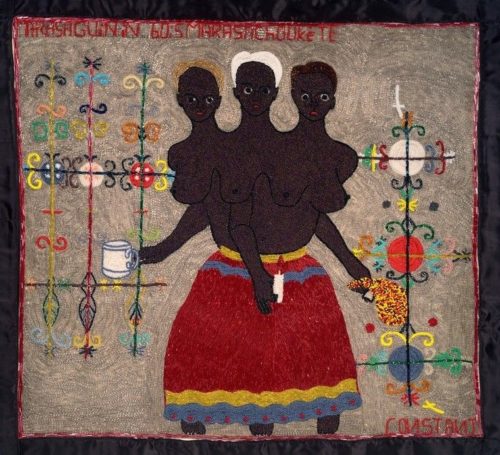
Myrlande Constant, beaded flag, Vodou arts.
“The chain breaks,
The wheel stops, and the noise of machinery,
And the desert is cleared, under the judicial sun
Of the final eye, and the awful evacuation
Cleanses.”
T.S. Eliot (The Family Reunion)
“Yes, one should forgive one’s enemies, but only after one has seen them hanged.”
Heinrich Heine
“To discover who people think they are, what they think they are doing, and to what end they think they are doing it, it is necessary ro gain a working familiarity with the frames of
meaning within which they enact their lives. This does not involve feeling anyone else’s feelings, or thinking anyone else’s thoughts, simple impossibilities. Nor does it involve going native, an impractical idea, inevitably bogus. It involves learning how, as a being from elsewhere with a world of one’s own, to live with them.”
Clifford Geertz (Available Light)
There is something, a sense of structure, for lack of any clearer description, lurking at the edges of culture today. Culture in the West anyway. A structural governor, a social and psychological control mechanism. A sense that growth of a certain kind is not quite possible any longer. Culturally speaking. That notions of meaning and valuation have changed dramatically over the last forty years, as have audience perceptions and attitudes. And while this is disturbing in one sense, and a sign of cultural atrophy, it is also, possibly, something that if reflected upon more deeply will be experienced as another sort of growth — or rather a way in which creating artworks can become more a process of dissecting the very of idea of growth, or of progress.
Certain poets and artists are seen as never quite fulfilling their potential. Of not living up to the promise of their early work. This idea is built into Western thought in general. It is both Christian, and Capitalist. W. H. Auden was such a poet, Orson Welles such a filmmaker. Charlie Mingus such a musical artist. R. G. Lienhardt wrote of Auden, in 1945…
“It has become increasingly obvious with each new publication that this poet’s greatest difficulty lies in determining quite what he wishes to express and in formulating an appropriate attitude towards it, and that, at any time, his equipment for dealing with his matter, in a technical sense, is vastly in excess of what is required.”
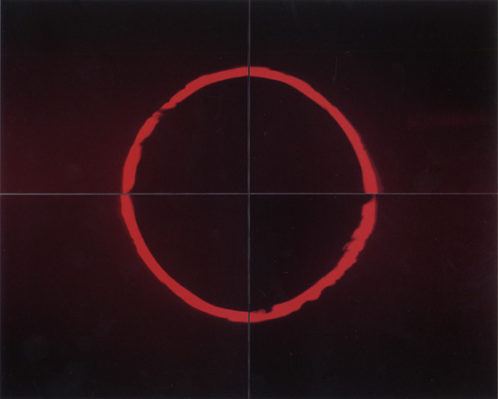
Garry Fabian Miller, photography.
All of these men were technically gifted. Preternaturally so. This is not quite the same thing as virtuosity, but it overlaps some. And all three of these men came to public attention roughly in the same period.
This is a, perhaps, convoluted way to return to contemporary culture, and to both this idea of a structural limiting of desire, imagination, and curiosity, and to, secondly, the ways in which contemporary society fits the subject to feelings of guilt and depression. For guilt is at its core connected to what Freud called a dejection, a deep misery that killed off interest in the outside world. A difficulty in accepting love, as well as giving it, though I suspect receiving love is today even more challenging for most people, is coupled to an expectation…or as I wrote last, anticipation…an anticipation of punishment, of the authority, some authority, inflicting a deserved sentence.
Now Freud thought the self doubt and recriminations of the guilty (melancholic) was a projection of sorts from a love object (impossible to accept) to the Ego. An ego that is already deformed and distanced in some fashion. But more on that below. Guilt is also part of a complex process of splitting between the ego and super ego.

Kazuna Taguchi
“…the sense of guilt is a means whereby an individual’s obedience or disobedience is obtained. Bound, at least in part, to remain unconscious, it is responsible for much suffering and among other thing leads to an idealisation of the persecutor, as well as to imitative behaviour (by imitating him the victim becomes his persecutor and in this way deludes himself that he has him under control). The core of these processes can be found in Abraham and, to a certain extent, Job, but we could go even further and also find uncritical idealisation in the submissiveness shown by Socrates’ disciples.”
Roberto Speziale-Bagliacca (Guilt, Remorse, and Responsibility After Freud)
Now Freud saw the origin of guilt drawn from a distant almost mythic past. As Freud wrote of the delusions behind feelings of guilt…“they owe their power to the content of historical truth which they have drawn from the repression of ancient, forgotten age.” And of course this explains a good deal about religious piety and the exaggerated emotions tied to religious practice. But it also connects to the foundations of storytelling, of narrative. Both Jewish tradition (a religion of the Father) and Christianity (of the son, but also, more recently, in a very peculiar way, the Mother…or even sister). Now, without going into an elaborate discussion of psychoanalytic theory regards guilt — though I will touch on it more below — an important aspect in the context of contemporary society is that much guilt forms before any act has been committed. Often its not even guilt at a fantasy. And the means to lessen the tension of this anxiety or guilt is go ahead and do something wrong, something clearly deserving of punishment.
Dostoyevsky was the great voice of this ur-guilt. But there is another aspect, too, which has to do with a deep seated hostility toward the Mother. Speziale-Bagliacca notes that Klein linked guilt to aggressiveness. The child has feelings of aggression toward the parent, and more acutely with the mother. And this is tied into an entire complex of devouring the source of nurture, toward the body that is the scene (!) of all original sensuous excitements. But for Klein, interestingly, even the desire for knowledge betrays aspects of aggression, and more, of sadism.
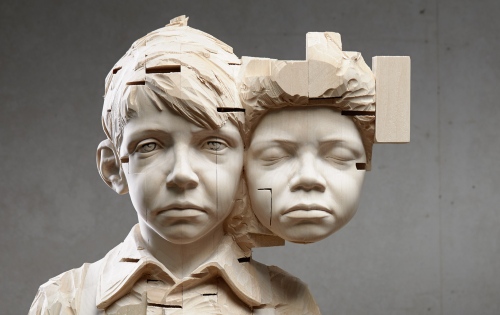
Gerhard Demetz
“Throughout her work Klein shows that she considers aggressiveness (together with the inhibition of aggressiveness) as the most important problematic impulse during the child’s development. Consequently the sense of guilt takes on a very special role. She also considers sadism as a manifestation of the death instinct. In 1935 she makes her most important statement on the subject of guilt: she describes guilt as something that arises out of what she calls the depressive position and which she therefore terms depressive guilt.”
Roberto Speziale-Bagliacca (Guilt, Remorse, and Responsibility After Freud)
The child feels authority is going to punish him or her, in a sense, for not internalizing the guilt felt. For, clearly, there is a question here as to why we internalize bad objects instead of just rejecting them. The answer in short form is guilt. And guilt is tied into very early trauma in the child and even infant. And to the mother. Hence, again, it is easy to see how religion recreates these mini dramas. I have said all stories are crime stories. And so they are. For the composing of narratives comes out of both aggression and sadism, and of guilt. But here I want to suggest that contemporary society today has created conditions that are akin to sort of pre-fabricated guilt stages or scenes. In the theatre of the mind. And it may be its not even that elaborate. A pre ordered guilt that is like trying on a jacket, off the rack. The child is so stunted by the absent parent, or the distracted parent or caregiver, that these primary aggressions and guilt are only partially developed. This raises questions about remorse in today’s world and the seemingly outsize demand that the guilty feel it. Maybe that is because they so completely don’t feel it, and are secondarily guilty about that.
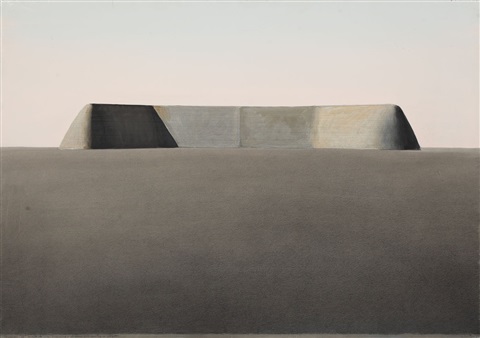
Horia Damian
One can also see the attractiveness of the criminal or abuser. The repressed guilts and anxieties of early childhood then find concrete form, more, are found to be familiar. I suspect in the contemporary world there are now always multiple versions of guilt at work in the subject.
Sort of coincidently Auden, in one of his very good essays, notes (per Shakespeare) that in landowning societies the sense of time is cyclical. Good harvests or bad, the seasons return. The future is expected to conform to the past. In mercantile society the future is unpredictable. In today’s societies of advanced capital, financialized and digital, there is no time. The ruling landowner is a giant telecom or hedge fund, a corporation — and hence cannot really be seen connected to time and space in the same way. The unpredictable is anticipated, though, and accepted. It is, in a way, a merger of the two. Guilt is tied into this because it is another robbery of the scene of trauma.
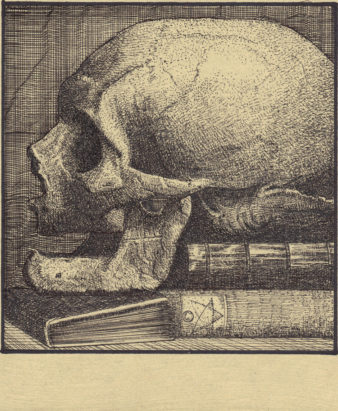
Richard Sica (bookplate)
Speziale-Bagliacca in his excellent book discusses tragedy, in relation to guilt. It would be useful, too, to look at scapegoating here. But for the moment a quick digression on the tragic. And while it is now commonplace almost to see tragedy as all but impossible in the contemporary world, it is also important to know more on why this seems true. I have written on this before, but I want to touch on another aspect here. Melanie Klein discussed in great detail the attachment the child has to the mother’s breast and the accompanying anxiety at failing to preserve this connection. And a guilt that comes out of failing to preserve it, but also a melancholy that is anticipatory — the feeling that this cannot last and the child is fighting against both the unconscious here, and outside persecutors. The tragic sense of guilt is an awareness and acceptance of it, but in theatre, the tragic play is a revealing in time, on stage, of what has been hidden. Today, there is ever less language suitable to express such awareness.
It is becoming impossible to not see the loss of language, and with it, a loss of a certain large part of thinking. The digital internet world of communication (sic) is one in which anticipation plays a profound role. Anticipation and expectation, and, like the Kleinian child, there is a buried depression that is built into the expectation of personal failure. A failure to preserve the breast. To sustain a connection. All expectation appears within a shadow field of disappointment. The addictive habitual smartphone user does not feel melancholy if his or her expectations are wrong or right, but does feel anxiety about that missing component. The experience of anticipation brings an anticipation of feeling, and it is now evaporated. But that anxiety can lead to a kind of secondary or tertiary guilt and melancholy. Only the contemporary melancholic is less reflective on his or her guilt and more concerned with the obligations of remorse. That the guilty attracts the sentencing of authority seems clear, I think. One knows people who seem walking invitations to punishment.

Henri Prestes, photography.
Our aggressiveness corresponds in proportion to how much our Super-Ego punishes us. But in a post post modern society of mass surveillance and domination, of constant digital electronic propaganda and indoctrination, the super ego is both more powerful and perhaps simultaneously less so. Klein was describing an interior world of the child that had connections (and Speziale-Bagliacca notes this) with schizophrenia and paranoia. And even Lacan was in part describing something malignant and psychotic in a sense. Splitting is never not trauma. Only the child adapts and adjusts. Freud called the super ego a Primitive God. A god who is petty and authoritarian. Again, this view of psychic formation resembles an archaic morality of tribal groupings. In the modern world of giant urban dysfunctional environments it seems that perhaps the primitive god is more aggressive in retaliation but also predictable — the child, and later if stuck in this point of development, the adult, can guilt-manage by anticipating what it knows is coming. The depression is delayed, I have a feeling, but because of the deterioration of thinking, of analysis on a personal level, the anxiety is changing into a psychosis of paranoia.

Matthew Dempsey, photography.
But to return to the idea of narrative and myth, and its relationship to morality, and then to our psychic formation — the attachments Klein describes are indeed, in part, an expression of Christian morality. But the relevant part is that that structural lack I started this post with is a cultural phenomenon. The contemporary paranoid narcissist is both creator and victim. There is a compulsive near need in people today to repeat something of that primary wound. To re-experience, if just that, the first pre anticipatory rupture with satiety. Today the constant compulsive incompleteness of nearly everything (certainly everything culture and artistic) is tied into the adult need for the familiar. Our incomplete self is a part of a continuum of incompleted reunion, but one that while missing the appointment is anxious. From the cancelled TV show, plot stopped without warning, to the stalled infrastructure projects, to the wars of aggression, re adjusted, re branded, and changed by name, there is little in the way of resolution. The loss of community, the guilt, and guilt is partly attached to Roman notions of guilt, not knowing what everyone else knows, the incomplete, the fragment, is now losing clarity or focus. Language cannot reach it. The sense is of an increasingly opaque world. And this toleration and anticipation, of the inarticulate, is creating a collective that persecutes those who ARE articulate.

Christoph Weber
Rene Girard and others have looked to see violence linked to religion and to the sacred. And that out of myth came ritual. That may well be, though for some reason I dislike the entire way this topic is approached by anthropologists. As I have said, religion itself came out of theatre. For the scene is there before the word. First is rupture, is splitting. The scene, the stage. The empty space for enacting and re-enacting the trauma. The theatre is then the place from which the word attaches. And then myth. Girard is very good, however, when discussing scapegoating and violence, and also memory and cultural institutions.
“The extraordinary number of commemorative rites that have to do with killing leads us to imagine that the original event must have been a murder. Freud, in Totem and Taboo, lucidly perceived this necessity. And the remarkable similarities among the sacrificial rites of various localities suggest that the murder was always of the same general type.”
Rene Girard (Violence and the Sacred)
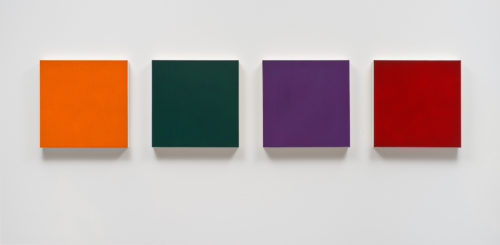
Marcia Hafif
For Girard, all ritual (and religion) is a re-enactment of the surrogate victim in sacrifice. It is therefore to keep violence outside the community. That is always fails suggests that our mental re-enactment subsumes the ritualistic one and that the ritual is there to help memory. The victim anticipates the ritual, the punishment, the persecution. Today the is something in the indifference of most people to the greater violences around them, and only in fact pay attention to particular *special* acts of violence, means that somehow, in some form of acceptable Id processes the subject has learned when to pay attention. Anticipates it. Expects it. The child is the actor and the analysand — repeating what cannot stop the guilt and melancholy.
There is something in our psychic formation that both is reflected in ritual, and in ritual violence, as well as by now shaping aspects of that formation.
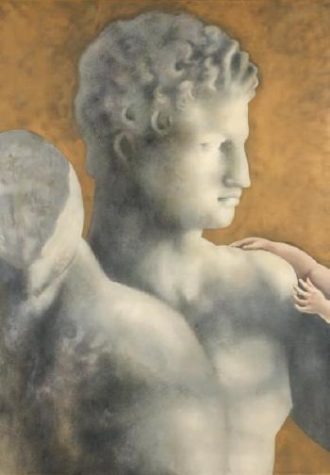
Harold Stevenson
Jonathan Z. Smith (The Domestication of Sacrifice)
“Thus in slight cases the ceremonial seems to be no more than an exaggeration of an orderly procedure that is customary and justifiable; but the special conscientiousness with which it is carried out . . . stamps the ceremonial as a sacred act.”
Sigmund Freud (Beyond the Pleasure Principle)
Religious rituals always contain at least the residue of ceremonial violence, and early communal acts of violent purification. Obsessive compulsives carry out the theatre of their disorder in, actually, exactly the same way. The aetiology is identical.

Jim Dine
“As best as I can judge, sacrifice is not a primitive element in culture. Sacrifice is a component of secondary and tertiary cultures. It is, primarily, a product of “civilization.”
Jonathan Z. Smith
Now, I think this is interesting. Firstly, only domesticated animals were butchered in sacrifice. There is no evidence of hunters practicing ritual sacrifice. It seems the product of societies in which a priest class has formed. An agrarian society then, which through institutionalized religious practices, is mythologizing after the fact. None of this detracts from the truth of psychic formation, but it does suggest the wholesale Western white interpretive gloss on early man, and early “primitive” (sic) cultures. The priest class is also, necessarily, forced to put into laws what came out of early re-enactments of childhood trauma. Those Paleolithic cave paintings found on several continents probably have little to do with any sort of religious practice. They might well be recreation for all we know. My suspicion is that (per Leroi Gourhan) the early marks are a precursor to alphabets, and possibly a form of establishing written language. They were likely exercises of some sort. But therein lies my point, I think. Exercises are repetitions, and all such exercises in the end amount to a kind of ur-theatre.

Gregor Törzs (Platinum Palladium print).
“…the optimal object is the nipple in the mouth, together with the holding and talking and familiar smelling mother … experienced concretely as a skin. Disturbance in the primal skin function can lead to development of a “second skin” formation through which dependence on the object is replaced by a pseudo-independence.”
Esther Bick (Notes on Infant Observation in Psychoanalytic Training. International Journal of Psycho-Analysis, 1968)
Bick and Judith Mitrani, and later Joyce MacDougall were sort of post Kleinians and were very important thinkers on contemporary childhood development, especially regards trauma and the resulting generations of more and more intellectually (and emotionally) crippled youth. Now let me backtrack a moment here; in regards to ritual violence and sacrifice. Walter Burkett quite cogently notes that around 6000 B.C., at the time of the Neolithic revolution, which entailed great migration to previously unheard of large urban centers, and a time when writing and social differentiation expanded, and culture per se was in a formative stage, the only sacrifice, ritual sacrifice that occurred, was entirely among the rulers, Kings, landowners and gentry. Or as Burkett put it, it was not the herdsmen but those who owned the herds. Animal sacrifice was not the province of hunters or workers. Ritual and ceremonial violence was then a part of the priest class encoding of religious observance.
So there is a question here regards text and ritual violence. Klein and her notion of intellectual pursuits, or curiosity, of a desire to learn being connected somehow to aggressiveness seems worth pondering. The reflective posture, the time and situation that allowed for philosophy was paid for by certain institutional developments. And that also means the imposition of laws. And how that connects to guilt in psychic formation is a complex and contested topic.
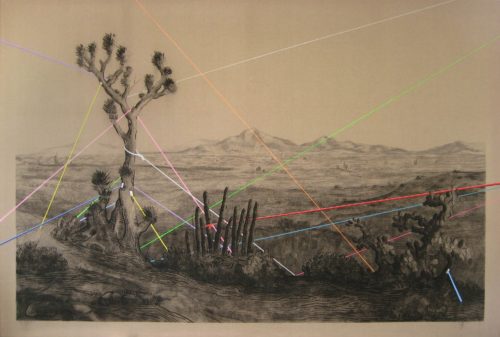
Alejandro Pintado
Guilt was not called guilt, was not contemplated as such, until a time when text and literacy was already established.
“Ignatius of Loyola completed his classic manual of devotion, The Spiritual Exercises. There, as the first set of exercises for the third week of retreat, he commends, for the contemplation at midnight, meditation on the events of the Passion of Christ spread out over seven days. In each of these, the individual is asked, first, to “call to mind the narrative of the event” and, second, to make a “mental representation of the place.” Here, all has been transferred to inner space. All that remains of Jerusalem is an image, the narrative, and a temporal sequence.”
Jonathan Z. Smith (To Take Place, Toward Theory in Ritual)
This was the road of increasing conceptualization. As Robert Harbison puts it….“A map seems the type of the conceptual object, yet the interesting thing is the grotesquely
token foot it keeps in the world of the physical, having the unreality without the far-fetched appropriateness of the edibles in communion, being a picture to the degree that the sacrament is a meal.” Early childhood trauma, which is recreated throughout life in some cases, is, either way, alive for everyone in daily life. The reason I asked at the start about the changes in valuation, culturally, is because my personal sense of art-making today is that media and pop culture, and worse, institutional propaganda, have not just intensified paranoia, and the role of the Super Ego, but have deconstructed the personality. Welles and Mingus and Auden were the first front edges of the spectacle destroying the artistic personality — and character. This is no judgement on their work. The question is rather in what way has public acceptance, or notoriety, changed not just individual artists (not to mention financial success) but rather the effect this de facto framing of *art* is altering the way society thinks about itself, and about its own culture.

Valdirlei-Dias-Nunes
The society of the spectacle is one in which sacrifice has been not only trivialized (shit, EVERYTHING is trivialized) but also neutralized. Girard suggests at a certain point animals were domesticated and bred specifically for sacrifice. Today, while there is no longer ritual sacrifice, there is also an ersatz sense of imitation. Hunting today is pantomime for the most part. Except of course animals die. But how do these vague residual imitations of ritual relate to our inner lives. Sporting events are effective primarily because of illegal betting on the games. The underground bookie is a sort of new priest class in that regard. The setting up of odds (usually using Vegas lines, and hence Vegas is today the temple of American sacrificial ritual) is a kind of ceremonial mass. A mass in which nobody is actually present.
“Because we think we know what it means for men to hunt animals, or to domesticate them. But do we? Why are these phenomena always interpreted religiously? That may be the major mistake of all previous theories of religion. They see religion-and, above all, ritual killing-as the mystery that should be explained by the less mysterious that surrounds it.”
Rene Girard (Notes from discussion at the Institute for Antiquity and Christianity at the Claremont Graduate School)
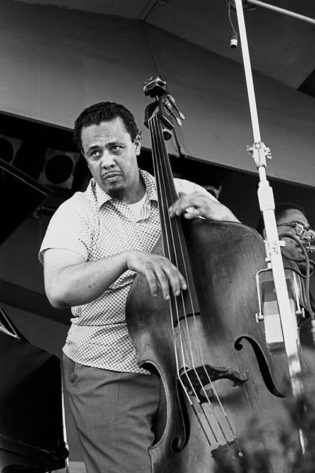
Charles Mingus, Newport 1959.
Religion is not arbitrary. Nor are the rituals that develop out of it. But the class element is what so profoundly mediates the entire subject. It is worth noting, and I believe Smith does, that there are no descriptions of rituals in the Bible. Only that rituals took place. I think in a future post it might be useful to examine the effect of those changes that took place with Paul and with the New Testament. But I digress.
Art, like religion, reproduces something that occurs in psychic development. And then later shapes that development to some degree.
“It becomes apparent through a consideration of ritual’s form that ritual is not simply an alternative way to express certain things, but that certain things can be expressed only in ritual.”
R.A. Rappaport
This is the truth. Robert Bly used to say ‘all learning takes place in ritual space’. So, looking at this immanent absence or lack, this structural presence that seems to pervade the psyche, as well as the social today — I sense that art can only be made by reduction in a sense. If we speak here of writing, then the process of discovering that interior trauma, which cannot be done, but perhaps the tracks or marks of that trauma, then the first action is to remove the rational. That starts with cliche or explanation or, more illusively the *meaning*. The meaning is always, from the creators point of view, the explanation. The truth then, if you like, cannot be understood. That which can only be said on stage is that which cannot be explained. That which is without message.
“The source of all poetry is the deep feeling of that which is inexpressible.”
Lucien Arreat
This is not to be confused with the empty. My favorite Mingus is him playing piano. My favorite Welles is, probably, Othello. These are the uncanny works. With Auden I’d rather read his essays.

Hajra Waheed
“In other words, whereas normal presymbolic autosensuality, as described by Tustin, is the seed that, when cultivated and nurtured within the context of human relationship, germinates, sprouts, and grows into object relations proper, I believe that if experiences of a sensory nature are left unprocessed by a thinking and feeling object, symbolic meaning fails to evolve out of the rudiments of the existential experience inherent in sensory contiguity and rhythmicity, and that these untransformed and “unmentalized experiences” become rigidified and hyper- trophied as fortified protections against the awareness of those primeval experiential states of terror related to bodily and emotional separateness.”
Judith Mitrani (A Framework for the Imaginary)
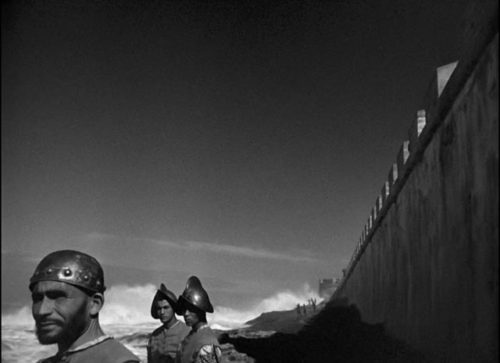
Othello (Orson Welles, dr. 1952/55)
The artist must have exactly those qualities of mind that advanced capitalism kills off, deforms, or, per Mitrani, renders hyer-atrophied and rigid. Additionally there are pre-approved *roles* available. This is the effects of marketing on one level, but its also partly the system of the market filling a need.
“If someone is naturally gifted with a“good’, i.e. `well-functioning”, preconscious, or has trained himself to acquire one, he is able to `see’, or to apprehend, various levels of reality and the points at which they meet. A `good’ preconscious works spontaneously on several levels, while a mediocre preconscious, or one which is overloaded, gets bogged down in the stereotypes and clicheÂs of prejudices and acquired mental habits. It tends to
rely on theoretical models that have been learnt rationally. It depends on the opinions of others and thus is only capable of limited freedom. Proust seems to be pointing out the “ethical” implications of this state of affairs (and this links it to guilt).”
Roberto Speziale-Bagliacca
The Greeks linked technical skills, things like carpentry or weaving, with skills acquired over time. A mental and psychological dexterity. But the goddess of this field, *Metis*, also was linked to magic. Again, the various historical phases that created migratory coercion, driving many into large cities, has always meant a loss of magic. That Neolithic revolution was likely the same. No more cave paintings.
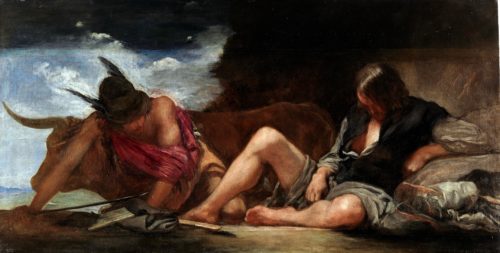
Velasquez (Mercury and Argos, 1659).
Magic accepts contradiction and paradox. The trend toward a technology or *tecne* was one that defined intelligence as logic, and a reason that rejected that which defied logic. That rejection was a kind of first policing of thought. For the Greeks this was the 5th century, was Plato and after. The loss of magic, and of Dionysian energy or emotion was by default strengthening the police reflex. The restrictive impulse was one that purged that which challenged its *rightness*.
“The patient, in the transference, when talking of objects far from his relationship with the analyst, is in fact also (or even primarily) speaking about his relationship with the analyst. This phenomenon, which psychoanalysis has emphasised so greatly but which is not exclusive to the analytical relationship, concerns all relationships and all human communication, since the transference is ubiquitous.”
Roberto Speziale-Bagliacca

Adam McEwen
The magical is also the dream. Our personal mythology. The intuitions of the Mother toward her infant were cultivated in pre-technological societies. Not all, but most. And the eradicating of the feminine over the course of western civilizational growth has meant Mothers have been integrated into a masculine hyper rational system …and Capitalism is the supreme expression of this. (and this is why a rise of authoritarian thinking among socialists and communists is so acutely destructive, for it betrays itself just another form of policing).
“Metis was the first spouse, or lover, of Zeus. While she was pregnant with Athena, Gaia and Uranas told Zeus that if he received a son after giving birth to a daughter, the son would then usurp him as he had done his own father, Chronos. Zeus, after using sweet words to persuade Metis to lie down beside him, all of a sudden opens his mouth and swallows her. No further mention is made of Metis ( ) When the time comes, Zeus has labour pains which take the form of a terrible headache. On the banks of Lake Titone, Zeus orders Ephesus (or, according to other sources, Prometheus) to split open his head with an axe. Out comes Athena fully armed: she has a helmet, a lance and, in common with her father Zeus, an aegis. The aegis is a pectoral, a kind of light shield made of goat hide…”
Roberto Speziale-Bagliacca
It is interesting that Xanthippe is banished with sarcasm when he questions the Platonic ideal of hyper rationality. Anyway, I am reminded of Reich here, for it is now a society that devalues yielding. Bourgeois feminism demands martial postures, both physical and mental. It is a hidden phallic rigidity. People have stopped breathing deeply. The steroid body, the gymnasium body, features a rigid abdomen. Not great for breathing. Or breathing deeply anyway. Depictions of sex and ardor are ever more rigid. Romance feels like Zeus having his head split open, giving birth to his daughter the warrior. And the constant reiteration of *service* –meaning military service is more and more openly connected to death.
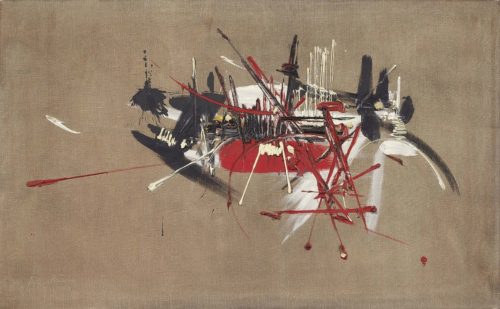
Georges Mathieu
All artists struggle to reclaim magic, if only intermittently. But the spectacle, which beyond the gradual creation of inflexible and distracted caregivers, the insufficient mother or parent, also neutralizes art through propaganda and misidentifying. But perhaps worst of all, in a sense, is the approval given some artists. The wrong approval come too early. Institutional approval, often, carries with it a sense of guilt. I know artists who said aloud, those guys at that big national theatre are morons. And they LOVE me and gave me a grant. Their judgements are flawed in the extreme. How am I deserving of this approval by idiots? But thats the simple version. The more complex is way approval and validation subtly demand duty, a duty to reproduce institutional product. And then finally the pernicious violence of overexposure. Movie stars suffer this on a visual level. They are simply photographed so much, to such an impossible degree, that they change. Their faces, but more significantly, their expressions, the look in their eyes. For more prestige or serious work, the over exposure takes the form of undeserved applause and exaggerated praise. For the young artist, especially ones with great talent and *dexterity* the violence done them is only evident decades later, often. Artists must take breaks. Go away. Move away. It was the best thing I ever did, certainly. But those breaks are like breaths. Stop the creative hyperventilation.
To contribute to this blog, you can use the paypal button at the top of the page. It is much appreciated.

A lot of interesting stuff here. I’m thinking, but meanwhile: Auden’s best thing is the libretto for The Rake’s Progress
https://www.youtube.com/watch?v=Mida0H24OfY
yes, its fabulous.
Two comments, first that new study indicates that the Iberian cave paintings are almost certainly created by Neanderthals as their dating has been pushed back to 60,000 years plus, 20,000 years before our species of humanity arrived there-so I’m proud to have some neanderthal genes. Second is that in the Roman pantheon of religions I am not aware of any that had human sacrifice as an element-so the introduction of human sacrifice into the mix with the creation of Christianity itself is somethig that needs examining. Much more efficient than the Aztecs and their mass human sacrifices, just have one man used as the universal sacrifice that can be celebrated over ad over again. In that regard Christianity is much more primitive than the “pagan” religions it replaced. Combine that with the theme of cannibalism that is also an essential ingredient of Christianity and you have a deeply disturbed society reflected in a deeply primitive belief system.
Im aware of the Neanderthal art, but Im still considering in what ways it is different …because it IS different. Second, my point was only that sacrifice was carried out …after 6000 BC anyway… by the royals and gentry. The priest class came to symbolize something that had both rationalized dionysian paganism, and entrenched a hierarchical rituals list to everything. And Girard saw sacrifice as substitute sacrificial. As for cannibalism….I might have to write a whole blog post on that one.
Thank you so much for this post – I have been reading every single one for a while now. Would love to see one fully dedicated to the loss of magic and tying into new rising popularity of astrology if that ever sparked your interest to dwelve into. Anyways, hope all is well
Preserved about 300 thousand.
for Countess Louise of Savoy
then only a few have reached us